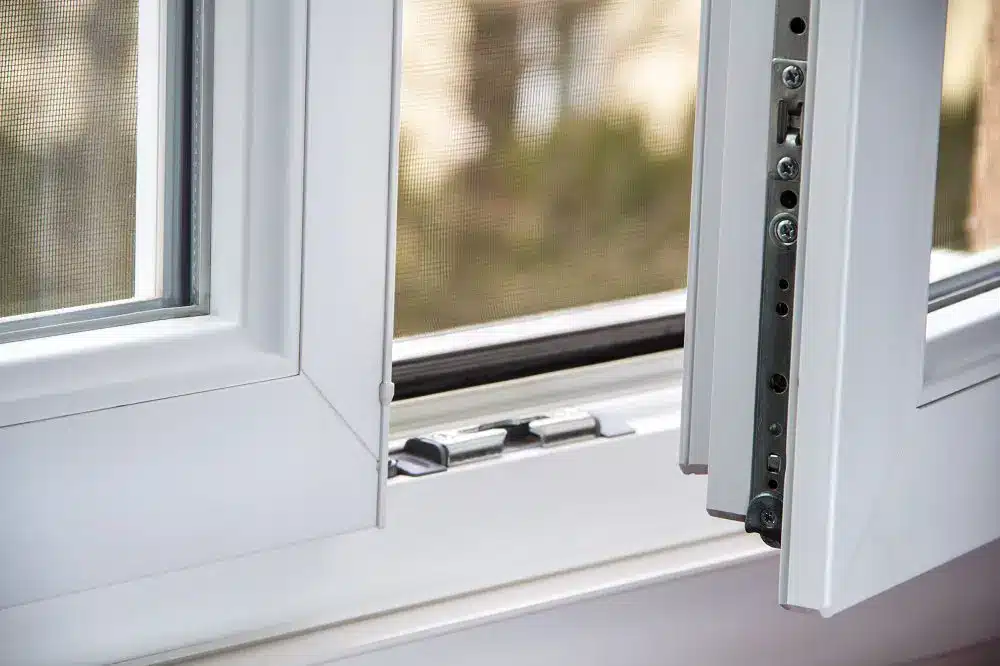In this article, we’ll go over the various types of nailing fins and clarify some frequent misconceptions about what they’re used for. You’ll also learn some of the basics of nail fin installation to avoid common window installation mistakes.
What Are Nailing Fins?
The main purpose of nailing fins is to secure the window to the wall sheathing and keep it together while the shims and screws are installed. Fins also help to keep wind and water out by working in conjunction with flashing and the weather-resistant barrier (WRB).
Not All Windows Have Nailing Fins
A replacement window, or an “insert,” does not have nailing fins because they are usually installed with the existing cladding on the wall, meaning there is no exposed sheathing for them to attach to. Replacement windows are secured onto the sides of the window openings through the window frames. In situations where nailing fins are considered impractical, commercial windows are typically installed into block or steel rough openings
Types of Nailing Fins
The two types of window nailing fins include integral and non-integral. Because the nailing fin and the window frame are produced as one solid piece, they are called “integral” nailing fins. All four corners of the windows are melted/welded together during assembly, forming a sealed shell around the whole perimeter of the window. Vinyl windows are the only ones with integral fins.
On the other hand, window frames made of wood, metal, and fiberglass will have non-integral nailing fins. During the assembly process, both the area where the fins meet at the corners as well as the seams between the fins and the frames need to be sealed during window installation. Non-integral nailing fins have various advantages. Because they can be folded down, they are less prone to damage during storage and transport. The folding fins of a window also allow it to be pushed through the rough opening from the inside, meaning it doesn’t need to be carried up a ladder or scaffolding. This is especially valuable when installing large windows on higher floors.
Nailing Fins Are Just One Part of the Installation
A window’s nailing fins do add structural integrity, but proper shim placement and frame screws are just as important as the fins themselves. As a matter of fact, nailing fins are often considered nothing more than a guide to the installation process and a method of holding the window in position while the shims and screws are installed.
Nailing Fins Need to Be Sealed
All nailing fins should be sealed to the wall on the rear side with an exterior-grade, non-shrinking, flexible sealant. Non-integral nailing fins must also be sealed to the frames they are attached to. Run self-adhesive flashing over the fin and up onto the window frame to accomplish this. At this stage, it is important to not apply sealant or flashing to the bottom nailing fin. This is because an unsealed bottom fin will create an escape route above the window for any water that finds its way past the building envelope.
New or Replacement Window Installation
Each window has its own requirements for sealants, flashing procedures, and nailing patterns. Make sure you follow the installation instructions created specifically for the window you are installing. If you are looking to simplify the installation process of new or replacement windows, the experts at Clearview Distributors are here to help! To discuss your project and learn about your options, give us a call at 719-488-2236 today!
A Guide to Window Nailing Fins FAQs
A window nailing fin is a thin, flat strip of material, typically made of vinyl or aluminum, that extends outward from the frame of a window. It is designed to provide a secure and stable connection between the window and the building’s framing, ensuring proper installation and creating a weather-tight seal to prevent water infiltration and air leakage.
Nailing fins are not required for all types of window installations, but they are highly recommended for new construction projects or when replacing windows in existing structures. They are particularly useful for securing windows in wood or vinyl siding applications, where they create a continuous seal. In some cases, such as with brick or masonry exteriors, alternative installation methods like mounting clips or brackets may be used instead.
Yes, it is possible to install a window without a nailing fin, but it is not recommended due to the potential drawbacks. Installing a window without a nailing fin may compromise the window’s ability to create a weather-tight seal, leading to increased risk of water infiltration, air leakage, and reduced energy efficiency. Additionally, without a nailing fin, the window may not be as securely attached to the building’s framing, increasing the risk of movement or dislodging over time.



